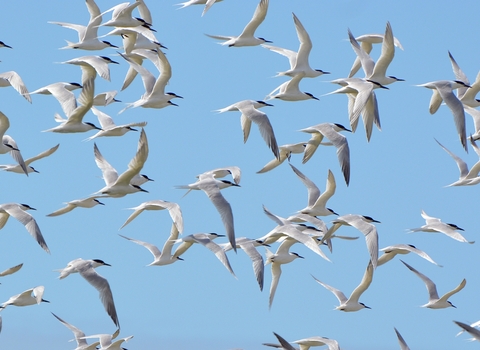Gwledd o Adar Môr
Am gyfnod byr o ychydig fisoedd mae Gwarchodfa Natur Cemlyn yn gartref i un o’r golygfeydd mwyaf rhyfeddol o adar môr yng Nghymru. Dilynwch y môr-wenoliaid wrth iddyn nhw ddychwelyd o’u tiroedd gaeafu i fagu teulu newydd a dysgu am y da a’r drwg wrth fyw mewn poblogaeth o fôr-wenoliaid. Darllenwch am sut mae’r Môr-wenoliaid pigddu yn dod yn eu blaen, a darganfod sut mae’r haf yn wahanol i Fôr-wenoliaid cyffredin a Môr-wenoliaid y gogledd. A chael y newyddion diweddaraf am weld adar anarferol!
2025
The new tern season is underway and we will keep you up to date on how the terns are get on, along with news about other wildlife sightings around Cemlyn.
March 2025
Through the month of March, Wildlife Trust and staff were busy getting the reserve ready for the arrival of the terns. As the month ended the first Sandwich terns were seen around the Bay.

© NWWT
2024
Mae tymor arall ar droed i’r môr-wenoliaid a byddwn yn rhoi’r wybodaeth ddiweddaraf i chi am sut mae’r môr-wenoliaid yn gwneud, a hefyd newyddion am y bywyd gwyllt arall sydd i’w weld o amgylch Cemlyn.
Awst 2024
Diwedd tymor arall...
... a sôn am dymor! Yn dilyn heriau 2023, mae wedi bod yn gymaint o bleser gweld y boblogaeth mor iach a chynhyrchiol eleni. Fe wnaeth tua 2000 o gywion Môr-wenoliaid Pigddu, 200 o gywion Môr-wenoliaid Cyffredin a 400 o gywion Môr-wenoliaid y Gogledd hedfan y nyth eleni, yn ogystal â chywion rhywogaethau eraill ar draws y warchodfa, sy’n gwbl ardderchog.
Rydyn ni eisiau dweud diolch enfawr wrth ein gwirfoddolwyr gwych ni sydd, gyda'i gilydd, wedi rhoi mwy na 200 o oriau o'u hamser, yn gwarchod ac yn monitro'r boblogaeth ac yn siarad gyda'n hymwelwyr ni - rydych chi'n anhygoel!
Diolch hefyd i bawb sydd wedi ymweld â’r boblogaeth a’r warchodfa a chefnogi mewn amrywiaeth o ffyrdd.
Mae’r môr-wenoliaid wedi gadael Cemlyn bellach ond efallai y cewch chi gip arnyn nhw o hyd, o gwmpas arfordir Gogledd Cymru, cyn iddyn nhw gychwyn ar eu siwrnai hir tua’r de. A chadwch lygad am y baneri coes oren!
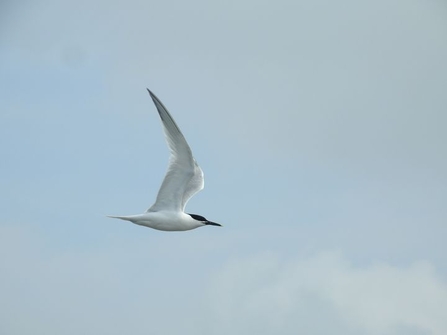
Tern at Cemlyn Nature Reserve © Hannah Smith
Gorffennaf 2024
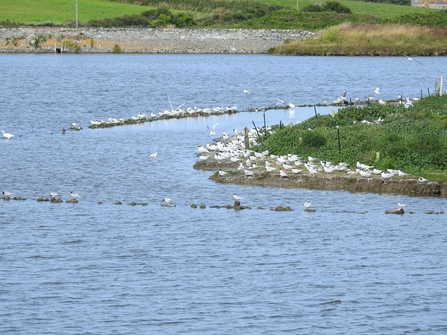
Cemlyn Nature Reserve terns © Hannah Smith
28 Gorffennaf Mae diwedd y tymor yn prysur agosáu ac mae'r ynysoedd wedi gwagio'n arw. Dim ond tua 20 yr un o fôr-wenoliaid cyffredin a môr-wenoliaid y gogledd, a rhwng 100 a 150 o fôr-wenoliaid pigddu, sydd ar ôl. Mae'r rhai sydd yma wedi dechrau sefyll yng nghefn yr ynys felly mae’r golygfeydd o'r esgair yn gyfyngedig iawn erbyn hyn! Ar ôl misoedd o gymaint o sŵn a symud cyson, mae'r tawelwch cymharol yn rhyfedd iawn.
Fodd bynnag, mae haid o hyd at 100 o ylfinirod yn nodwedd gyson bellach yn ein caeau cyfagos ni. Mae nifer y crehyrod yn cynyddu, fel maen nhw’n gwneud yr adeg yma o'r flwyddyn, ar ôl gadael eu tiroedd magu. Mae heidiau o linosiaid, corhedyddion y waun a’r nico yn ymgasglu o amgylch y warchodfa hefyd.
18 Gorffennaf Mae tua dwy ran o dair o’r boblogaeth o fôr-wenoliaid wedi gadael erbyn hyn – yn oedolion a chywion wedi hedfan y nyth. Mae'r rhai sy'n weddill wedi lledaenu ar draws y warchodfa. Mae tua 50 o gywion sydd heb hedfan y nyth eto, ond mae digon o amser iddyn nhw wneud hynny o hyd. Mae’r pâr o wylanod Môr y Canoldir ar yr ynys fawr wedi magu un cyw, sy’n rhyfeddol o swil, ond i’w weld yn aml o gwmpas y môr-lyn.
11 Gorffennaf Newyddion ardderchog! Mae tri chyw cwtiad torchog bach iawn wedi deor heddiw ac maen nhw wedi bod yn dod o hyd i’w traed yng nghanol y cerrig crynion. Mae'r ddau riant yn gofalu amdanyn nhw er eu bod yn annibynnol iawn yn barod. Mae’r adar yma’n elwa o gael yr ardal wedi’i chau gyda rhaff ar yr esgair – nid yn unig y mae hynny’n cadw ein môr-wenoliaid ni’n hapus ac yn atal unrhyw darfu arnyn nhw, ond hefyd mae’n darparu lle i adar eraill sy’n nythu ar y ddaear fagu, yn ddiogel rhag traed a phawennau!
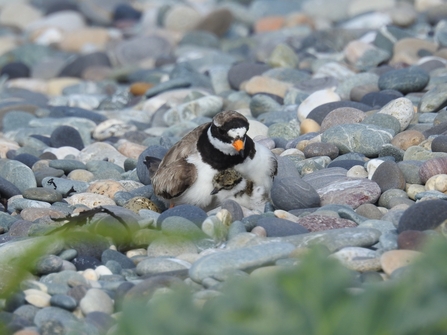
Ringed Plover and chick at Cemlyn ©Hannah Smith
9 Gorffennaf Mae cywion y môr-wenoliaid pigddu yn yr awyr go iawn bellach! Mae’r boblogaeth wedi bod yn symudol iawn yr wythnos yma, gyda’r holl adar yn hedfan o gwmpas y môr-lyn sawl gwaith y dydd, gyda dim ond ychydig o adar yn aros ar y ddaear yn ystod y cyfnod yma.
Mae rhai o’r môr-wenoliaid pigddu gyda fflagiau lliw wedi’u gweld ar Afon Clwyd! Mae llawer nad ydyn ni'n ei wybod o hyd am y gwasgaru ar ôl i’r cywion hedfan y nyth ac mae fflagiau lliw yn helpu i greu darlun o ble maen nhw'n mynd. Os ydych chi ger yr arfordir, cadwch lygad amdanyn nhw!
Mewn mannau eraill yn y warchodfa, fe ddeorodd 5 o gywion hwyaid cribog yn gynharach yr wythnos yma. Maen nhw’n tyfu'n gyflym ac mae posib eu gweld nhw’n tasgu eu ffordd ar draws y môr-lyn!!
4 Gorffennaf Roedd 1690 o gywion môr-wenoliaid pigddu y tro diwethaf i ni gyfrif ac mae llawer o’r rhain yn yr awyr o amgylch yr ynysoedd bellach. Mae digon o ysgwyd adenydd a neidio’n digwydd hefyd, er bod rhai’n dal i gael trafferth codi digon i fynd yn bell iawn!! Mae tua 78 o gywion môr-wenoliaid y gogledd a 22 o gywion môr-wenoliaid cyffredin hefyd. Mae llawer mwy o oedolion yn dal i eistedd mewn nythod felly rydyn ni’n disgwyl i'r niferoedd yma gynyddu. Mae rhai o’r môr-wenoliaid y gogledd yn hedfan yn hyderus iawn ac mae posib eu gweld yn archwilio ochr y môr i'r esgair, a’u rhieni’n eu gwylio’n ofalus o hyd.
Fe wnaethon ni gyfrif 310 o gywion gwylanod penddu, a gwelwyd llawer o’r rhain yn mentro ymhellach i ffwrdd o amgylch y warchodfa. Fodd bynnag, roedd rhai cywion bach fflyfflyd i'w gweld heddiw, dim ond newydd ddeor!
1 Gorffennaf Cael ein siomi wnaethon ni gan y tywydd ond mae rhywfaint o fywyd gwyllt i'w weld bob amser i godi calon rhywun. Doedd y glaw mân ddim i’w weld yn poeni’r draenog oedd yn chwilio am fwyd!
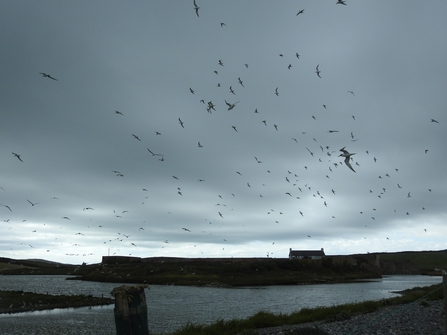
Cemlyn Nature Reserve terns © Hannah Smith
Mehefin 2024
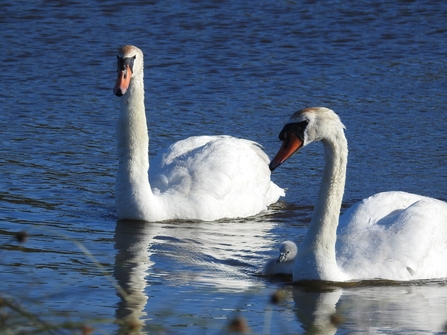
Swans and cygnet Cemlyn © Hannah Smith
Mehefin 28 Mae un cyw alarch yn ychwanegiad newydd at y llu o adar ifanc o amgylch y warchodfa.
Mehefin 25 Mae mwy na 1,000 o gywion môr-wenoliaid pigddu i'w gweld bellach, gyda llawer mwy wedi'u cuddio efallai neu eto i ddeor. Mae digon o lysywod y tywod yn cael eu cludo i mewn a nawr bod y cywion yn fwy, felly hefyd y bwyd! Rydyn ni hefyd wedi cyfrif 280 o gywion gwylanod penddu a rhai wedi hedfan y nyth - mae'r rhan fwyaf o'r rhain yn hedfan pellteroedd byr bellach, ond yn dal i aros yn agos at eu rhieni. Mae’r môr-wenoliaid cyffredin a môr-wenoliaid y gogledd yn gwneud yn dda hefyd – maen nhw dipyn y tu ôl i’r môr-wenoliaid pigddu, ond rydyn ni wedi gweld o leiaf 70 o gywion y môr-wenoliaid hyn.
Mewn mannau eraill o amgylch y môr-lyn a'r esgair mae cywion pïod y môr yn tyfu'n gyflym ond yn dal i gael gofal da gan eu rhieni. Er gwaethaf eu henw yn Saesneg, oystercatchers, dydyn nhw ddim yn bwyta wystrys mewn gwirionedd, ond yn hytrach yn bwyta cocos, cregyn gleision neu bryfed genwair yn bennaf. Mae’r unigolion yn arbenigo mewn gwahanol fathau o fwyd, a bydd y cywion yn dysgu sut i fwydo gan eu rhieni.
Mehefin 20 Bellach mae cannoedd o gywion môr-wenoliaid ar yr ynysoedd. Maen nhw’n symudol iawn, yn tyfu bob dydd ac yn llwglyd yn gyson. Rydyn ni wedi gweld llawer o adenydd yn fflapio ac yn ymestyn, ond mae rhyw wythnos i fynd eto cyn i’r rhai hynaf hedfan am y tro cyntaf. Ddoe fe roddwyd modrwy coes fetel a baner oren i 139 o gywion y môr-wenoliaid pigddu, y ddau â chod unigryw (edrychwch ar y llun isod). Mae hyn yn ffynhonnell ddata bwysig iawn, sy’n ein galluogi ni i wybod ble mae ein môr-wenoliaid ni’n mynd ar ôl iddyn nhw ein gadael ni ym mis Gorffennaf. Mae’n ein helpu ni i fonitro iechyd y boblogaeth ac yn rhoi gwybodaeth am y ffordd orau o helpu môr-wenoliaid, ar raddfa fyd-eang, nid dim ond yma yng Nghemlyn. Ac mae'n golygu ein bod ni’n gwybod bod rhai’n dod yn ôl i fagu yma ar ôl cyrraedd aeddfedrwydd! Mae gan boblogaethau eraill o fôr-wenoliaid gynlluniau modrwyo gyda lliwiau gwahanol, ac rydyn ni wedi gweld llawer ohonyn nhw eleni. Mae môr-wenoliaid o bob rhan o’r DU ac Iwerddon, a’r Iseldiroedd, wedi’u gweld yma i gyd, sy’n dangos bod atynfa fawr i Gemlyn. Mae’r gyfres ddata yma’n rhywbeth y gall pawb gyfrannu ati – drwy gadw llygad a rhoi gwybod am unrhyw un o’n hadar ni gyda baner oren pan fyddan nhw’n gadael y fan yma ar ddiwedd y tymor. Mae’r holl fodrwyo’n cael ei wneud dan drwydded gan fodrwywyr profiadol a medrus.
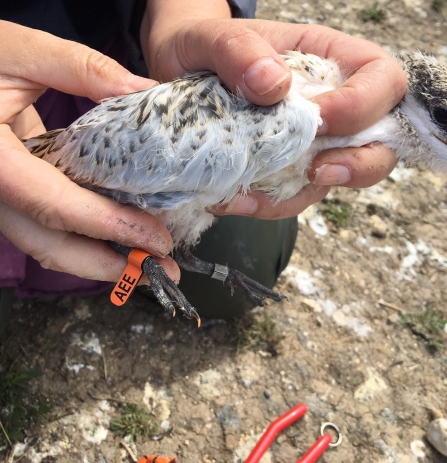
Sandwich tern ringing © Phil Woollen (Taken under licence issued by Natural Resources Wales)
Mehefin 13 Roedd heddiw yn debycach i fis Chwefror na mis Mehefin, ond mae’r môr-wenoliaid wedi bod yn dal ati beth bynnag, gan frwydro yn erbyn gwyntoedd 45mya i ddod â llysywod y tywod i’r ynysoedd, a’r cywion sy’n gyson newynog yn aros amdanyn nhw gyda’u pigau ar agor. Mae llawer o oedolion yn eistedd ar wyau o hyd ond ym mhob man rydych chi'n edrych mae cywion yn sgwtian o gwmpas, yn ymestyn ac yn tyfu ar gyflymder trawiadol!
Mehefin 7 Mae ein cyfrif blynyddol o’r poblogaethau, sy’n cael ei wneud o dan drwydded gan CNC, yn rhan hanfodol o fonitro iechyd y boblogaeth ac, eleni, mae'n newyddion gwych! Gyda'i gilydd fe wnaethon ni gyfrif mwy na 2,000 o barau o Fôr-Wenoliaid Pigddu, 210 o barau o Fôr-Wenoliaid y Gogledd a 90 o barau o Fôr-Wenoliaid Cyffredin yn nythu ar draws y ddwy ynys! Mae hyn yn newyddion gwych yn dilyn yr achosion o ffliw adar y llynedd, ac mae ein niferoedd ni bron yr hyn oeddent yn 2022. Mae mwy o gywion yn deor bob dydd ac mae'r rhai hŷn yn mentro ymhellach oddi wrth eu rhieni, gan eu gwneud yn haws eu gweld. Mae oedolion o bob rhywogaeth yn brysur yn dod â llysywod y tywod yn ôl, gyda llif cyson o Fôr-wenoliaid dros y esgair.
Mehefin 5 Rydyn ni wedi cofnodi mwy na 15 o rywogaethau o adar rhydio y tymor yma, gan gynnwys Pioden y Môr sy'n magu. Mae Cwtiad y Traeth, y Cwtiad Torchog a Phibydd y Mawn yn bwydo ar y draethlin yn aml ac rydyn ni hyd yn oed wedi cael ambell i Bibydd Cambig yn ymweld!
Mehefin 1 Gwelwyd cywion cyntaf y Fôr-wennol Bigddu heddiw. Ar hyn o bryd maen nhw'n eithaf swil o flaen y camera. Mae'r rhieni'n gwneud gwaith gwych yn eu cadw nhw'n gynnes ac yn eu gwarchod, felly dim ond cipolwg gawson ni pan wnaethon nhw godi eu pennau bach allan i gael eu bwydo. Fe fyddan’ nhw’n dod yn haws eu gweld wrth iddyn nhw dyfu a dod yn fwy symudol, ac wrth i fwy ddeor dros y dyddiau nesaf.
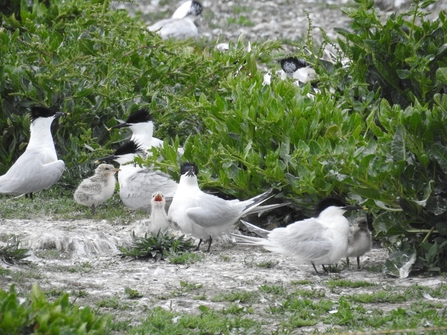
Sandwich terns at Cemlyn © Hannah Smith
Mai 2024
Mai 26 Fe ymwelodd gwennol dingoch â Chemlyn y penwythnos yma. Maen nhw i'w gweld fel arfer yn Ne Ewrop yn ystod yr haf, ond weithiau maen nhw'n teithio’n rhy bell wrth fudo o Affrica drofannol yn y gwanwyn. Dim ond y trydydd cofnod swyddogol i Ynys Môn yw hwn, a’r cyntaf ers 2008!
Mai 23 Diwrnod gwyllt! Fe fu bron i’r penllanw gyrraedd ein man gwylio arferol ni ar yr esgair, gyda thonnau, chwistrell o’r môr a gwynt yn cyfarch yr ychydig ymwelwyr dewr ddaeth allan heddiw. Er bod y nifer cynyddol o gywion y gwylanod penddu wedi bod yn swatio i gadw allan o’r gwynt, mae’r môr-wenoliaid wedi bod yn brwydro yn erbyn yr elfennau, yn ogystal ag adar eraill o amgylch y warchodfa. Roedd newyddion am yr etholiad cyffredinol a’r sylw lleol sydd wedi’i roi i adroddiadau am gynnig ynni niwclear newydd posibl yn Wylfa yn ein hatgoffa ni o frwydrau’r gorffennol a’r rhai sydd i ddod yn y dyfodol. Wrth sôn am swyddi a chyllid, mae’n werth cofio hefyd, yn ôl yn 2019, ar ddiwedd yr ymchwiliad cyhoeddus i ddatblygiad arfaethedig Wylfa, bod yr Arolygiaeth Gynllunio wedi dod i’r casgliad bod diffyg tystiolaeth wyddonol wedi’i chyflwyno i ddangos na fyddai’r gwaith adeiladu’n tarfu ar y poblogaethau o Fôr-wenoiaid y Gogledd a Môr-wenoliaid Pigddu yng Nghemlyn gerllaw. Roedd ofnau y byddai'r adar hyn wedyn yn cefnu ar eu tiroedd magu yng Nghemlyn o ganlyniad. Yn ogystal, roedd swyddogion cynllunio arbenigol yn teimlo y byddai'r cynllun yn methu â chyrraedd rhai o safonau amrywiaeth biolegol y Cenhedloedd Unedig. Wrth i dymor 2024 fynd rhagddo byddwn yn cadw llygad barcud ar ddatblygiadau eraill.
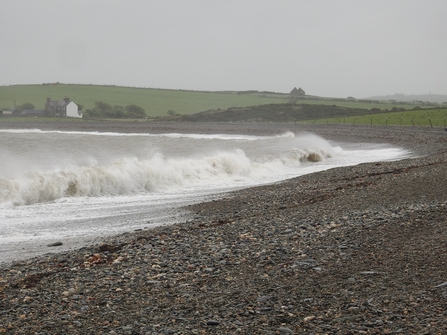
High Tides and Storms at Cemlyn May 2024 © Hannah Smith
Mai 16 Cyw cyntaf i wylan benddu wedi deor heddiw! Mae’r ddau riant yn rhannu’r cyfrifoldebau gofalu, gan gynnwys deor y ddau ŵy sy’n weddill yn y nyth a sicrhau bod y cyw yn cael ei fwydo, yn gynnes ac yn sych.
Mai 12 Mae’r ynysoedd wedi dod yn amlwg brysurach (ac yn fwy swnllyd!) yr wythnos yma – bellach mae gennym ni fwy na 2,000 o Fôr-wenoliaid Pigddu, 250 o Fôr-wenoliaid y Gogledd a 150 o Fôr-wenoliaid Cyffredin. Mae tua 750 o Fôr-wenoliaid Pigddu yn eistedd ar wyau nawr. Mae'r ddau riant yn rhannu'r gwaith deor felly mae'n bosibl gweld yr wyau pan fydd yr oedolion yn cyfnewid lle neu’n symud ychydig yn y nyth! Mae yma hefyd 160 o Wylanod Penddu ar nythod.
Mai 8 Erbyn hyn, gyda’r nos, mae nifer y môr-wenoliaid pigddu sy'n clwydo yn fwy na 4000 o adar; mae tua 70 o adar yn edrych fel eu bod yn eistedd ar nythod bellach. Mae hyn fwy neu lai yr un fath â’r llynedd ar gyfer nifer yr adar sy’n eistedd, ond yn uwch ar gyfer yr adar sy’n clwydo. Mae niferoedd da o fôr-wenoliaid cyffredin a môr-wenoliaid y gogledd yn bresennol hefyd ac yn weladwy iawn ar y brics. Mae hyd at 3 phâr o wylanod Môr y Canoldir wedi cael eu gweld. A barcud coch ysblennydd uwch ben fore heddiw.
Mai 3 Gyda mudo’r gwanwyn yn ei anterth, mae niferoedd yr holl rywogaethau o fôr-wenoliaid yn cynyddu ac rydyn ni hefyd wedi clywed telor yr hesg a’r troellwr bach. Ond un o uchafbwyntiau'r dyddiau diwethaf oedd pibydd y graean a phâr o bibyddion cambig; roedd y pibyddion cambig newydd gael eu plu haf ac roedd yn gyferbyniad da i’r adar yn eu plu gaeaf.

Curlew sandpiper in winter and summer plumage at Cemlyn © Hannah Smith
Ebrill 2024
Ebrill 30 Mae’r môr-wenoliaid pigddu yn cynyddu mewn niferoedd ac yn perfformio eu harddangosfeydd carwriaethol bendigedig. Mae ychydig mwy o fôr-wenoliaid cyffredin o gwmpas hefyd. Roedd pibydd y graean yn arddangos yn dda hefyd.
Ebrill 20 Gwelwyd y fôr-wennol gyffredin gyntaf heddiw ac mae pâr o wylanod Môr y Canoldir yn nythu yn ôl pob tebyg.
Ebrill 12 Helo mawr a chroeso’n ôl i Hannah a Mark, sy'n dychwelyd am dymor arall fel wardeniaid yng Nghemlyn. Un o'u tasgau cyntaf oedd clirio ar ôl Storm Pierrick. Yn anterth y storm roedd y tonnau’n taro yn erbyn yr esgair o ro mân gan ddymchwel sawl postyn a rhaff. Mae’r wardeniaid yn rhan bwysig o reoli’r ymwelwyr niferus â Chemlyn ac yn helpu i atal tarfu ar y boblogaeth o fôr-wenoliaid. Wrth iddyn nhw weithio, roedd y cyntaf o’r môr-wenoliaid pigddu ar gyfer eleni yn clwydo ar yr ynysoedd. Allan ar y môr-lyn, fe ddaeth adar cyfarwydd yr haf, hwyaden yr eithin a'r hwyaden frongoch, i’r golwg.
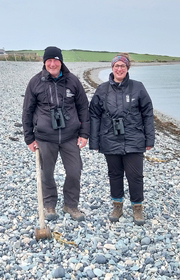
NWWT Chris Wynne
Mawrth 2024
Yn ystod wythnosau olaf mis Mawrth fe fu’r staff a gwirfoddolwyr yn paratoi ar gyfer tymor newydd y môr-wenoliaid yng Nghemlyn. Gosodwyd y byrddau cored yn eu lle, a physt a rhaffau ar yr esgair i helpu i reoli'r ymwelwyr niferus, a gosodwyd bocsys nythu a ffens ar yr ynysoedd. Cafwyd golygfa arbennig o bâr o freision yr eira ar Drwyn Cemlyn a gwelwyd haid fawr o’r cwtiad aur.
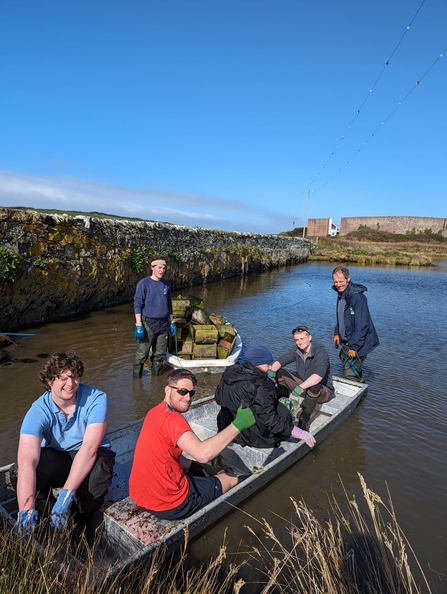
Volunteers at Cemlyn © NWWT
Summer 2023
Here's how things went at Cemlyn in 2023
August 2023
August 6th There are now only about 200 adult and 30 fledgling terns left on the islands, most of them on the small island and the beach. It won’t be long now until the lagoon is quiet once more… Look out for them moving up and down the coast, feeding up before their long migration.
However, the reserve will still have its Autumn and Winter residents! Lots of Curlews are moving down from their summer breeding grounds – we’ve seen groups of over 100 this week! We have also sighted Sanderling, Redshanks and large flocks of Linnets and Starlings.
We are also happy to inform you that the Shelducks and Ringed plovers have fully fledged, and the Cygnets and Mergansers are getting much bigger.
July 2023
30th July There are around 400 terns (including common and arctic) left now. Of the juveniles, there are only about 20 Sandwich, 20 Common and 30 Arctic terns. It looks quite bare on the islands but there is a lot of feeding activity going on, and the birds that are left are still making quite a noise… the sound of summer at Cemlyn. The terns are flighty, as they prepare to leave, and circling the lagoon in the evenings – they look even more beautiful in the evening light.
The cygnets are even bigger! The merglings are becoming expert divers, and the shelducklings have started to branch out on their own - we even saw one bobbing on the sea today!
Turnstones and Curlews have been seen in larger numbers on the reserve this week as they begin to move from their breeding grounds. The wind has also been blowing the offshore birds closer to the coast, so we got some great views of Gannets and Manx shearwaters today!
23rd July The islands are becoming a little more quiet as more terns begin the migration to their wintering grounds. The 2023 fledglings will follow their parents all the way back to Africa! However, the young ones do not tend to make the full migration back to the UK until they are between two and three years old – so, we won’t see these young birds again for a while… good luck little ones.
On the reserve we still have around 400 sandwich terns on the islands, including 100 fledglings. Common and arctic terns number around 100 on the islands, with another 200-300 on the beach and rocks, plus about 100 fledglings.
The four ringed plover chicks are still roaming the ridge and the three cygnets continue to grow, as do the seven merglings - who are now practicing their diving skills. And the shelducklings are almost fully-grown!
21st July Convolvulus Hawk-moth( Agrius convolvuli) in the trap this morning, another first for Cemlyn. This is a large immigrant moth (5-6 cm), with an average of 100 individuals spotted annually, mainly in the south of England. It feeds on tubular flowers such as tobacco plants, petunias, lilies and phlox. The proboscis is extremely long and is the only moth in the UK to feed on these species of plant.
16th July There are about 100-150 sandwich terns left to fledge (with around 300 sandwich chicks that have already left the reserve). However, there are between 75-100 sandwich terns still sitting. About 40-50 common terns have successfully fledged, with around 10 or so left. Similarly, 40-50 arctic terns have fledged so far, with about 25 still to fledge. Most of the sandwich terns are occupying the back half of the large island, whilst the common and arctic have moved to the seaward side of the ridge and beach. Tern school is in session as the young ones learn to fly and fish!
The Avocets adults have left the reserve. Sadly, none of the chicks survived (we cannot be sure exactly what happened to them). Perhaps the adults will return next year, we will have to wait and see…
Elsewhere, the cygnets are still a trio, the merglings are still a septuplet and there are twelve surviving shelducklings (getting rather large!). We can also confirm that we have had two successful breeding pairs of ringed plovers! One set has fledged but there are still a family of six (four chicks!) roaming the shore on the inside of the ridge, so keep your eyes peeled!
We have also had a record number of little egrets on the reserve this season – up to 28 so far!
12th July Last Saturday night we put the moth trap out at Cemlyn and found a Pine Hawk-moth (Sphinx pinastri) - only been recorded in North Wales twice before, and this is the first record on Anglesey!! The Pine Hawk-moth's distribution is usually in the south and east of England where it is recorded in small numbers each year.
9th July Despite the avian flu we are still seeing success amongst the terns that are left. The first Sandwich terns to emerge have fledged and have been seen further down the coast at Llanfairfechan, and some along the River Clywd. The Common and Arctic tern fledglings are stretching their wings over the lagoon and ridge and will be following the Sandwich terns very soon. There are still some very young tern chicks emerging and still some yet to hatch.
The avocet adults are still around on the large island, however, we are sad to say the chicks are no longer with us. All seven of the merglings have been seen out and about today, and there are still eleven shelducklings about the reserve.
4th July We have spotted red-breasted merganser ducklings out on the lagoon! Seven, we think... The first sighting of the season, and the first time in a while we have had Merglings on the reserve
June 2023
30th We have closely monitored the impact of bird flu at Cemlyn; the colony is suffering an increasing number of cases, but the colony seems to be surviving; only time will tell how many of this year’s chick will survive to fledge – there are several hundred Sandwich, common and Arctic tern chicks present along with black-headed gull fledglings. The avocet chicks also seem to be surviving. But there was a highlight when a white-tailed eagle was seen flying over the reserve
25th The wardens have been show-casing the diversity of wildlife at Cemlyn as part of 30 Days Wild. Including a memorable 125 species of moth in one night’s survey.
18th There are now around 560 sandwich tern chicks over the two islands, and roughly 45 common tern and 40 Arctic tern chicks! Parents are constantly to-ing and fro-ing over the ridge, trying to keep up with the demand for food. The majority of prey items being brought in are sand eels, as we would expect. Other food items we have seen this season include clupeids, gadids, mackerel, rockling and even squid.
A lot of the black-headed gull chicks are almost fully fledged, the oystercatcher chicks are out and about. The avocet pair have been incubating their eggs for a while now – only the third breeding site in Wales and a first for Anglesey. The avocet eggs are due to hatch any day now. Elsewhere on the reserve; the swans have three cygnets!
13th We featured on Springwatch! You can still see the footage via the Wildlife Trust Youtube channel.
11th A beautiful day on the reserve – perfect weather for the Wardens’ Walk. We saw birds, butterflies and moths, grey seals and wildflowers a plenty. It was also an exciting day on the islands. Chicks of all tern species are out. The Black-headed gull chicks are swimming around now; there are two Mediterranean gull chicks, oystercatcher chicks, and the avocet has been turning her eggs! We have around 300 Sandwich tern chicks, 10 Arctic, and 4 common tern chicks. And to top off the day, a Little tern popped in briefly to say hello!
2nd 800-1000 pairs of sandwich terns appear to be nesting now and, even though we are down around 50% on last years’ numbers, they seem extremely settled. The first chicks have also been seen.
Arctic and common terns - about 80 pairs of each - should also be producing their little ones soon. However, all the species of tern are still mating! We are also looking forward to seeing some Med gull chicks soon too
In other news, we have had some exciting new visitors this week – a pair of Avocets! These beautiful birds have been with us for several days now and have been observed mating. They seem to be making themselves at home, feeding and resting on the large island. Perhaps they are getting comfortable too…
A small number of dead birds have also been collected for testing for avian flu; but so far the disease does not seem to have spread far in the colony as a whole.
May 2023
24th Every season brings old and new challenges for the seabird colony at Cemlyn. This year has brought with it a new menace. We have confirmed that a number of dead birds discovered at Cemlyn were infected with avian flu. At the moment, the colony is very active with thousands of birds present, including those sitting on eggs or with small chicks present. But all those involved at Cemlyn are extremely concerned. Read more about the situation:
21st The Sandwich terns that are sitting (around 800 birds now) are very settled, and at last we are starting to see them bring in some decent sized sand eels. Although, this has prompted some kleptoparasitic behaviour from the black-headed gulls!
The first of the black-headed gull chicks are out – around 10 little fluff balls!
Common and Arctic terns continue their courtship and mating, with around 85 birds already sitting.
14th We now have around 1,500 Sandwich terns in during the day, with around 600 of these sitting. Overnight we have between 3-4,000 Sandwich terns roosting. Breeding activity is around one week slower than last year. We think this is because of the cold weather we have been having. Colder sea temperatures mean that their main prey items, sand eels, are also behind in their breeding cycle. This may explain why more birds are out during the day, as they may have to travel further to find suitable feeding grounds - although from what we have observed, the terns are still finding ample amounts of sand eels.
There are around 1,000 roosting common and Arctic terns overnight now. We are seeing around 250 Arctic and 80 common terns during the day. They have started to nest this week too (around 50 arctic and 30 common terns sitting) – so the arctic terns are still outnumbering the commons! We also have 2 Mediterranean gulls sitting on the small island and one on the big island – exciting! And finally, we also have a visiting roseate tern - it’s in and out most days, so come and visit and see if you can spot it!
2nd The first of the early Sandwich Tern arrivals started incubating and there were ~100 present on the large island during the day, with up to 4,000 roosting overnight. Around 200 Arctic and 100 Common terns drifted in and out all day, with many more roosting overnight (~400 and 200 respectively). Although we don't expect all of these Arctic and Common Terns to stay, a few pairs of each species were displaying.
There have been up to 10 Mediterranean gulls of various ages seen regularly on the two Islands, and their distinctive call can often be heard around the reserve. Other recent highlights include a summer plummage bar-tailed godwit, little ringed plover and common sandpiper
April 2023
April 29th Arctic terns out numbered the common terns (100 to 75) - unusual! Larger numbers of arctic terns started to arrive a couple of days ago and are an impressive sight when they go up! The common and Arctic terns are still quite flighty as they have yet to settle.
We now have large numbers of Sandwich terns in during the night (about 2000!) but during the day numbers are much lower (30-50), as they go out to sea to forage. The Sandwich terns that remain during the day seem very settled and are happily displaying courting behaviour. Today we saw the first signs of mating too!
Read about the added excitement of the unexploded WW2 shell on the warden's Facebook page!
April 18th A bracing North Easterly as 60/70 terns roosted on the larger Island during the day. But up to 600 terns have been observed roosting on the Island in the evening, a sure sign that the breeding season is progressing through its early stages. Look out for courtship display behavior as we move further into the breeding season! We also have a number of Med gulls roosting. There are also lots of wheatear and meadow pipits passing through.
April 6th There are now about 60 Sandwich terns roosting on the islands
March 2023
Following some very high Spring tides, preparations were completed for the new tern season. Wildlife Trust staff and volunteers spent several days through March working to prepare for the arrival of the terns. This includes preparing the weir, putting out tern nest boxes, erecting the electric fence around the islands and putting out posts and rope to help manage visitors on the ridge.
Black-headed gulls were starting to show courtship behavior. Black-headed gulls are present all year round at Cemlyn and can be seen feeding around the shore and in the fields. But from mid March onwards the birds start to pair up. Mediterranean gulls were seen lagoon and islands. Fingers crossed they can nest successfully again this year.
A large flock of golden plover was also present around the islands and were often seen flying overhead in an amazing formation
The first Sandwich tern was seen on the reserve on March 17th ... unless somewhere knows differently! Sandwich terns are the first to arrive back at Cemlyn; numbers may fluctuate for the next few weeks but they will be gradually building
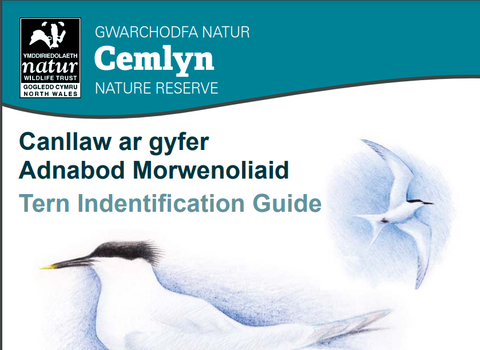
Canllaw ar gyfer Adnabod Morwenoliaid
Yng Nghemlyn mae un o'r poblogaethau mwyaf o forwenoliaid yn y DU. Pwrpas y canllaw yma yw eich helpu i adnabod y prif rywogaethau yr ydych yn debygol o'u gweld yma yn ystod misoedd yr haf.
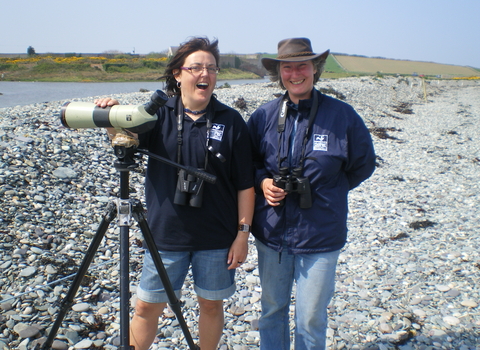
Trudi CLARKE & Dawn WILDE (2008)
Dewch i gyfarfod y môr-wenoliaid
Ymunwch â’r wardeiniaid am daith gerdded o amgylch Bae Cemlyn a chyfle i glywed am y boblogaeth o fôr-wenoliaid sydd yno – un o’r poblogaethau mwyaf yng Nghymru.

Cylchdaith rhithiol
Darganfyddwch beth sydd yn wneud Gwarchodfa Natur Cemlyn y le mor wych i’r Môr-wenoliaid a beth rydym yn wneud i helpu nhw i ymgartrefu yno! Cymrwch daith rhithiol gyda ein infograffig rhyngweithiol (gyda diolch i brosiect LIFE Roseate Tern).
Terns at NWWT Cemlyn nature reserve © Nia Haf Jones
Ymwelwch â Gwarchodfa Natur Cemlyn
Wedi’i leoli ar arfordir gogleddol gwyllt Ynys Môn, gyda’i esgair unigryw, hirgrwn o ro mân, mae Cemlyn yn safle anhygoel i ymweld ag ef. Yr amser gorau i ymweld â’r safle yw o Fis Mai hyd at Fis Gorffennaf pan mae cytrefi o Môr-wenoliaid Pigddu, Cyffredin a’r Gogledd, yn nythu ar yr ynysoedd yn y lagŵn. Yr unig gytref nythfa o fôr-wenoliaid pigddu yng Nghymru ac yn olygfa bywyd gwyllt trawiadol – peidiwch â'i fethu!

